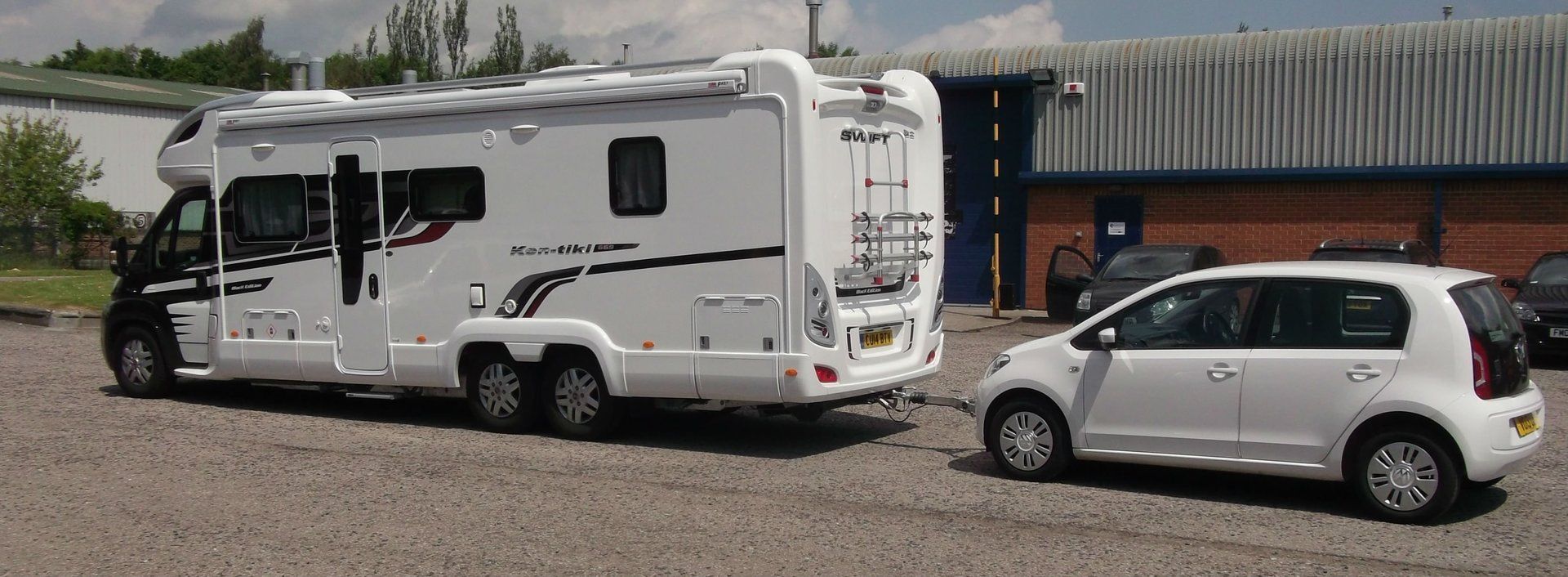Electronic 'A'-frame braking sytem
The SVS Electronic 'A'frame braking system: Due to complexity of manufacture and fitting, this product is not available during the Covid-19 situation.
For some time our engineers have been viewed with both bemusement and incredulity the claims made, half truths, exaggerations and downright lies told by companies pushing so-called 'electronic' braking systems for cars towed on 'A' frames, and that's not to mention the eye-watering prices! We will be introducing a far better engineered system, with superior performance, more reliable components far greater margins of safety, and a much more realistic price!!
Here's why:
Firstly does your small towed car need a braking system when towed behind a 3 1/2 tonne + motor-home NO, unbraked trailers of the up he 750kg can be towed behind most medium sized cars weighing less than half the weight of the motor-home. However you are REQUIRED to have an operational braking system as the D.F.T (Dept. For Transport) ruling is, that a car being towed on an 'A' frame is effectively a trailer, and if a trailer has brakes, they must work. Its that simple!
We have major concerns with existing systems
The method of attachment (to the towed car). This is often simply by towing on the existing crash beam using the existing towing eye, cutting another hole through the bumper, and fixing another 'eye' to the other side. This is a thoroughly unsafe practice as, firstly the crash beam is not designed to take this sort of loading's, (for example on the original 'smart' cars the crash beam is only attached by three 8mm bolts per side!) Attaching the second 'eye' facility requires welding in new attachments into a beam which often high strength or 'Boron' steel, safe welding to which, requires specialist knowledge of the type of steel and the correct welding wire, gas, etc none of which is likely to be available to the fitters of this equipment.
The flimsiness of the 'A' frame itself. Whilst they may be adequate for straight line towing, the sideways forces exerted when going round tight corners should not be underestimated. Our own frame is only a little heavier at around 12kg, but is vastly stronger.
The operating principle of all the existing systems is to say the least bizarre. All work by using an 'accelorometer' to detect deceleration, and once detected, to apply the brakes. In practice this means the car has to be slowing down before the brakes apply themselves, putting cyclic loading's onto the 'a'-frame and attachments. The majority of systems currently offered are of American origin and include 'toy' sized compressor units, which if they fail have to be purchased from importers, who seem strangely reluctant to quote prices for replacement parts!
Here's how we do it:
- Attachments - we use a purpose made, vehicle-specific internal tow-frame which attaches to strong points on the towed car without removing or replacing the crash beam.
- Projections - no illegal lumps sticking out of the front just neat 'eyes' which can be removed in seconds when not towing.
- Compressor/vacuum pump - to provide compressed air to supply the pneumatic actuator and provide vacuum for the servo, ( to eliminate any silly gripes about 'Dead Pedal')
- The ECU - Which only operates when the motor-home brakes are applied to avoid the 'tail dragging the dog'. Simple and reliable modular design allows individual components to be replaced in the unlikely event of this being necessary.
- The pneumatic actuator - which operates via a 'Bowden' cable to avoid having an air cylinder stuck on the brake pedal.
- The 'A' frame - weighing around 12kg folding down to just 750mm length for storage, and manufactured almost entirely from stainless-steel. The 'A' frame incorporates a system to detect any loading above a preset threshold level, caused by the motor-home braking, and immediately 'instructs' the operating system to apply the brakes. Also incorporated is a 'cushion' to absorb shock loading.
- Safety systems- the 'A' frame incorporates both a robust restraint cable to prevent the car becoming detatched should the coupling head become dislodged, but also a break-away system to apply to cars brakes should the restraint cable fail, giving double the security.
- Warning systems- A radio link to the motor-home (just plug it into the auxiliary socket) lights up an LED when the car brakes are applied, so the driver knows they're working.
- Reversible - Unless the motor-home brakes are applied, the system does not function, moving reversing function, allowing the car to be reversed without drag, in accordance with trailer regulations.
System requirements:
The motor-home needs a standard fully wired 13 pin socket on the tow-bar its to maintain the battery charge on the towed car (a legal requirement). This socket also supplies current for cars rear lamps and indicators.
Being released in 2019
Opening hours:
mon to fri:
09:00 - 17:00
weekends:
Contact directly/By appointment
Contact us:
3a, Astwith close, Chesterfield, Derbyshire, S425UR
01246 - 854917
chesterfield_aframes@outlook.com
